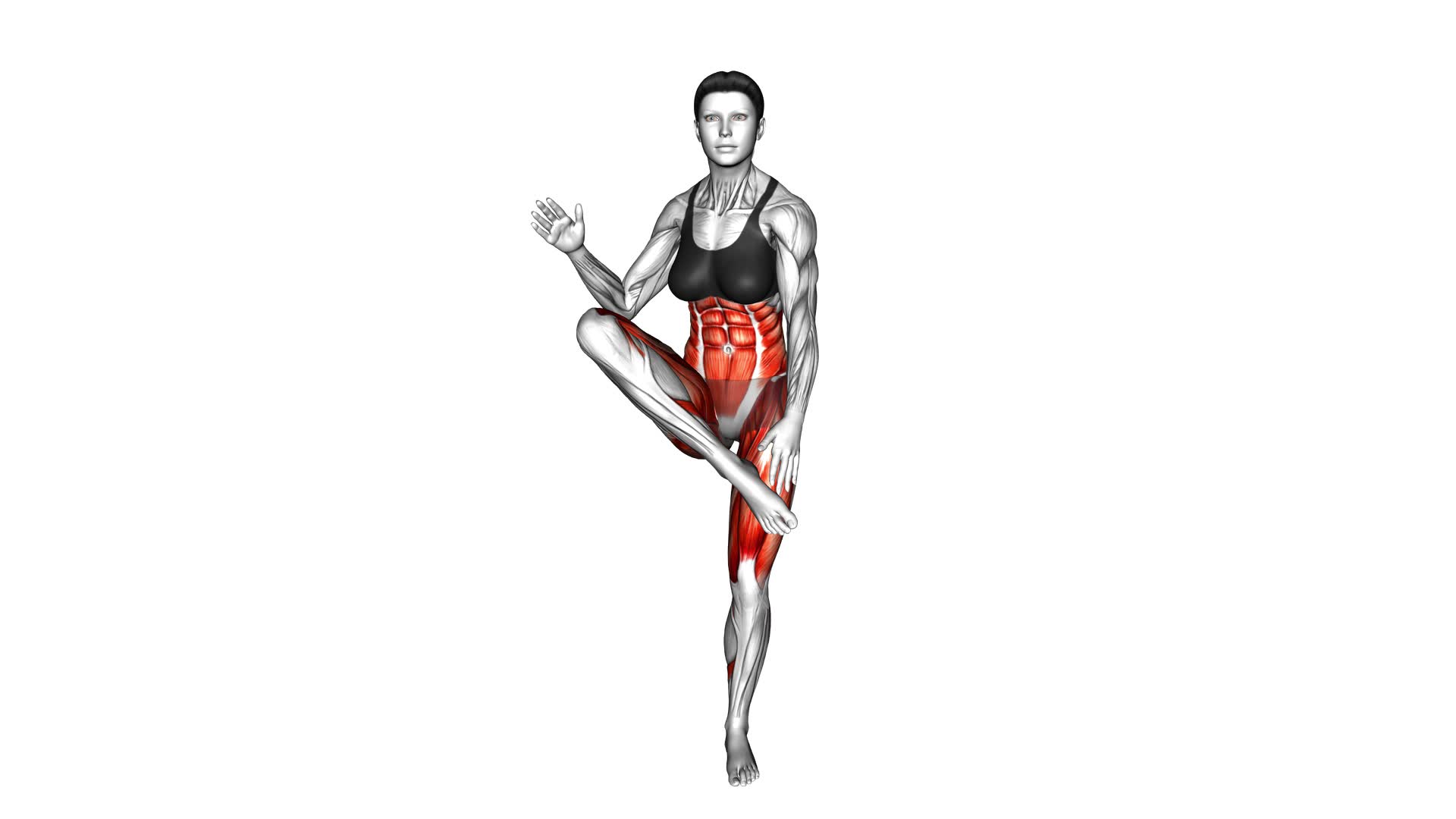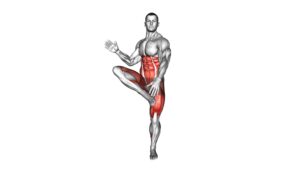Alternating Ankle Touch (female) – Video Exercise Guide & Tips

Are you looking for a quick and effective exercise to tone your legs? Look no further than the Alternating Ankle Touch!
Watch This Exercise Video
This exercise targets your lower body, specifically your glutes, hamstrings, and quads.
In this video exercise guide, we'll show you the proper form and technique, along with modifications for different fitness levels.
Say goodbye to common mistakes and hello to maximum effectiveness with our expert tips.
Get ready to feel the burn and achieve those toned legs you've always wanted!
Key Takeaways
- Targets lower body muscles such as glutes, hamstrings, and quads
- Improves balance and core strength
- Engages multiple muscles in the lower body for better stability
- Increases flexibility in hamstrings, calves, and lower back
Benefits of the Alternating Ankle Touch
You can experience improved balance and core strength through the benefits of the Alternating Ankle Touch exercise. This exercise engages multiple muscles in your lower body, helping to improve your muscular engagement and overall stability. By reaching down and touching your ankle with your opposite hand, you aren't only working your core muscles, but also engaging your hip flexors, glutes, and quadriceps. This exercise requires coordination and control, which helps to strengthen the stabilizing muscles in your legs and hips.
In addition to improved balance and core strength, the Alternating Ankle Touch exercise also offers benefits in terms of flexibility. As you reach down to touch your ankle, you're stretching the muscles in your hamstrings, calves, and lower back. Over time, this can lead to increased flexibility in these areas, helping to prevent injuries and improve your overall range of motion.
Incorporating the Alternating Ankle Touch exercise into your workout routine can be a great way to challenge your balance, strengthen your core, and improve your overall flexibility. Whether you're an athlete looking to enhance your performance or simply someone wanting to improve your everyday stability, this exercise can be a valuable addition to your fitness regimen.
Proper Form and Technique
To perform the Alternating Ankle Touch exercise with proper form and technique, maintain a strong posture and engage your core muscles throughout the movement. This will help you maximize the benefits of the exercise and reduce the risk of injury.
Here are some important tips to ensure proper form and technique:
- Common Errors:
- Avoid slouching or rounding your back. This can strain your lower back and diminish the effectiveness of the exercise.
- Don't rush through the movement. Maintain control and focus on engaging your abdominal muscles to stabilize your body.
- Proper Alignment:
- Stand tall with your feet hip-width apart and your shoulders relaxed.
- Keep your chest lifted and your gaze forward.
- As you reach down to touch your ankles, hinge at your hips and maintain a slight bend in your knees.
- Engage your core muscles to support your spine and maintain proper alignment throughout the exercise.
Modifications for Different Fitness Levels
For individuals at varying fitness levels, there are modifications available for the Alternating Ankle Touch exercise. If you're a beginner, you may find this exercise challenging at first. To modify it, you can start by lying on your back with your knees bent and your feet flat on the ground. Instead of reaching for your ankles, you can simply reach towards your knees or shins. This will reduce the range of motion and make the exercise more manageable for beginners.
On the other hand, if you're at an advanced fitness level and find the basic version of the Alternating Ankle Touch too easy, there are modifications to make it more challenging. One option is to add a weight to the exercise. You can hold a dumbbell or a medicine ball while performing the exercise to increase the resistance. Another modification for advanced fitness levels is to increase the speed of the movement. Instead of touching one ankle at a time, you can try to alternate between ankles quickly, making the exercise more dynamic and intense.
Common Mistakes to Avoid
One common mistake to avoid when performing the Alternating Ankle Touch exercise is improper form. Maintaining proper technique is crucial to ensure that you're targeting the correct muscles and avoiding potential injuries. Here are some common mistakes to watch out for:
- Rounded back: Keep your back straight throughout the exercise. Avoid hunching over or rounding your shoulders, as this can strain your neck and back.
- Lifting the head: Resist the temptation to lift your head up towards your knee when reaching for your ankle. Instead, focus on engaging your core and using your abdominal muscles to lift your upper body.
- *Pro tip: Imagine a tennis ball between your chin and chest to help maintain proper alignment.*
- Using momentum: Avoid swinging your upper body or using momentum to reach for your ankle. This diminishes the effectiveness of the exercise and puts unnecessary strain on your lower back.
- *Pro tip: Engage your core and perform the movement slowly and controlled to maximize the benefits.*
Tips for Maximum Effectiveness
For maximum effectiveness during the Alternating Ankle Touch exercise, focus on maintaining proper form and engaging the correct muscles. This will ensure that you get the most out of your workout and avoid common misconceptions that may hinder your progress. One important tip is to keep your core engaged throughout the exercise. This will help stabilize your body and prevent any unnecessary movement. Additionally, make sure to keep your gaze forward and avoid looking down at your feet. This will help maintain proper alignment and prevent strain on your neck.
When it comes to equipment needed for the Alternating Ankle Touch exercise, you don't require any specialized equipment. All you need is a comfortable workout mat or a soft surface to perform the exercise. However, if you want to challenge yourself further, you can incorporate ankle weights into your routine. Ankle weights can provide additional resistance, making the exercise more challenging and effective. It's important to start with lighter weights and gradually increase the resistance as you become stronger and more comfortable with the exercise. Remember, the key is to focus on maintaining proper form and engaging the correct muscles for maximum effectiveness.
Frequently Asked Questions
How Many Calories Does the Alternating Ankle Touch Exercise Burn?
The alternating ankle touch exercise is a great way to work your core and improve your balance.
While it's important to note that the exact number of calories burned can vary depending on factors like weight and intensity, this exercise can help you burn calories and contribute to weight loss when combined with a balanced diet and regular exercise routine.
To perform the exercise properly, lie on your back with your knees bent, and alternate reaching towards your ankles with your hands.
Can the Alternating Ankle Touch Exercise Help Reduce Belly Fat?
The alternating ankle touch exercise is one of the best exercises for reducing belly fat. By engaging your core muscles and promoting overall fat burning, it can help you achieve a toned and flat stomach.
Incorporating this exercise into your routine regularly will provide numerous benefits, such as improved balance and flexibility.
Is It Safe to Perform the Alternating Ankle Touch Exercise During Pregnancy?
During pregnancy, it's generally safe to perform the alternating ankle touch exercise. However, it's important to modify the exercise to accommodate your changing body.
Avoid lying flat on your back and instead perform the exercise while propped up with pillows. This exercise can help strengthen your core and improve balance, which are beneficial during pregnancy.
Remember to listen to your body and consult with your healthcare provider before starting any new exercise routine.
How Often Should the Alternating Ankle Touch Exercise Be Done to See Results?
To achieve optimal results from the alternating ankle touch exercise, it's important to consider the ideal frequency.
By regularly incorporating this exercise into your routine, you can reap its benefits.
The alternating ankle touch exercise helps improve core strength, stability, and flexibility.
For best results, aim to perform this exercise at least 2-3 times per week.
Consistency is key, so make sure to stay committed and gradually increase the intensity as your fitness level improves.
Can the Alternating Ankle Touch Exercise Improve Balance and Coordination?
Improving stability and coordination are two of the key benefits of ankle strengthening exercises like the alternating ankle touch. By regularly incorporating this exercise into your fitness routine, you can enhance your balance and overall coordination.
The alternating ankle touch targets the muscles in your ankles, helping to strengthen them and improve their ability to support your body. This exercise can be a valuable addition to your workout regimen if you're looking to enhance your balance and coordination.
Conclusion
In conclusion, the alternating ankle touch exercise is a great way to strengthen your core and improve your balance.
By following proper form and technique, you can maximize the effectiveness of this exercise.
Remember to modify the intensity according to your fitness level and avoid common mistakes for optimal results.
Incorporate this exercise into your routine for a stronger and more stable lower body.
Keep up the good work!

Author
Years ago, the spark of my life’s passion ignited in my mind the moment I stepped into the local gym for the first time. The inaugural bead of perspiration, the initial endeavor, the very first surge of endorphins, and a sense of pride that washed over me post-workout marked the beginning of my deep-seated interest in strength sports, fitness, and sports nutrition. This very curiosity blossomed rapidly into a profound fascination, propelling me to earn a Master’s degree in Physical Education from the Academy of Physical Education in Krakow, followed by a Sports Manager diploma from the Jagiellonian University. My journey of growth led me to gain more specialized qualifications, such as being a certified personal trainer with a focus on sports dietetics, a lifeguard, and an instructor for wellness and corrective gymnastics. Theoretical knowledge paired seamlessly with practical experience, reinforcing my belief that the transformation of individuals under my guidance was also a reflection of my personal growth. This belief holds true even today. Each day, I strive to push the boundaries and explore new realms. These realms gently elevate me to greater heights. The unique combination of passion for my field and the continuous quest for growth fuels my drive to break new ground.







